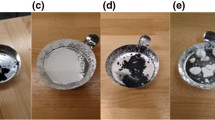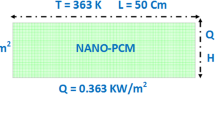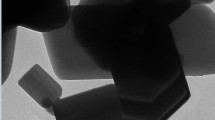Abstract
Changes in the thermal conductivities of paraffin and mono ethylene glycol (MEG) as a function of β-SiC nanoparticle concentration and size was studied. An enhancement in the effective thermal conductivity was found for both fluids (i.e., both paraffin and MEG) upon the addition of nanoparticles. Although an enhancement in thermal conductivity was found, the degree of enhancement depended on the nanoparticle concentration in a complex way. An increase in particle-to-particle interactions is thought to be the cause of the enhancement. However, the enhancement became muted at higher particle concentrations compared to lower ones. This phenomenon can be related to nanoparticles interactions. An improvement in the thermal conductivities for both fluids was also found as the nanoparticle size shrank. It is believed that the larger Brownian motion for smaller particles causes more particle-to-particle interactions, which, in turn, improves the thermal conductivity. The role that the base-fluid plays in the enhancement is complex. Lower fluid viscosities are believed to contribute to greater enhancement, but a second effect, the interaction of the fluid with the nanoparticle surface, can be even more important. Nanoparticle-liquid suspensions generate a shell of organized liquid molecules on the particle surface. These organized molecules more efficiently transmit energy, via phonons, to the bulk of the fluid. The efficient energy transmission results in enhanced thermal conductivity. The experimentally measured thermal conductivities of the suspensions were compared to a variety of models. None of the models proved to adequately predict the thermal conductivities of the nanoparticle suspensions.





Similar content being viewed by others
References
Zhou DW. Heat transfer enhancement of copper nanofluid with acoustic cavitation. Heat Mass Transf. 2004;47:3109–17.
Patel HE, Das SK, Sundararajan T, Nair AS, George B, Pradeep T. Thermal conductivities of naked and monolayer protected metal nanoparticle based nanofluids: manifestation of anomalous enhancement and chemical effects. Appl Phys Lett. 2003;83:2931–3.
Lee S, Choi SUS, Li S, Eastman JA. Measuring thermal conductivity of fluids containing oxide nanoparticles. ASME J Heat Transf. 1999;121:280–9.
Beck MP, Sun T, Teja AS. The thermal conductivity of alumina nanoparticles dispersed in ethylene glycol. Fluid Phase Equilibria. 2007;260:275–8.
Oh DW, Jain A, Eaton JK, Goodson KE, Lee JS. Thermal conductivity measurement and sedimentation detection of aluminum oxide nanofluids by using the 3x method. Int J Heat Fluid Flow 2008;29(5):1456–61.
Murshed SMS, Leong KC, Yang C. Enhanced thermal conductivity of TiO2—water based nanofluids. Therm Sci. 2005;44:367–73.
Liu MS, Ching-Cheng Lin M, Huang I-T, Wang CC. Enhancement of thermal conductivity with carbon nanotube for nanofluids. Heat Mass Transf. 2005;32:1202–10.
Jwo CS, Teng TP, Hung CJ, Guo YT. Research and development of measurement device for thermal conductivity of nanofluids. J Phys. Conference Series 13, 7th international symposium on measurement technology and intelligent instruments; 2005. p. 55–58.
Li J, Porter L, Yip S. Atomistic modeling of finite-temperature properties of crystalline β-SiC; Thermal conductivity and effects of point defects. Nucl Mater. 1998;255:139–52.
Koo J, Kleinstreuer C. Impact analysis of nanoparticle motion mechanisms on the thermal conductivity of nanofluids. Heat Mass Transf. 2005;32:1111–8.
Keblinski P, Phillpot SR, Choi SUS, Eastman JA. Mechanisms of heat flow in suspensions of nano-sized particles (nanofluids). Heat Mass Transf. 2002;45:855–63.
Xue QZ. Model for effective thermal conductivity of nanofluids. Phys Lett A. 2003;307:313–7.
Maxwell JC. A treatise on electricity and magnetism, vol. 1. II ed. Oxford, UK: Clarendon press; 1881. p. 435.
Hamilton RL, Crosser OK. Thermal conductivity of heterogeneous two component systems. I&EC Fundam. 1962;1(3):187.
Xue Q, Xu WM. A model of thermal conductivity of nanofluids with interfacial shells. Mater Chem Phys. 2005;90:298–301.
Acknowledgements
The authors would like to acknowledge financial support from Arak University, research support from the Institute for Colorants, Paint and Coating (ICPC), Tehran-Iran and the Arak Petrochemical Company, Arak-Iran.
Author information
Authors and Affiliations
Corresponding author
Rights and permissions
About this article
Cite this article
Hosseini, S.M., Moghadassi, A.R., Henneke, D. et al. The thermal conductivities enhancement of mono ethylene glycol and paraffin fluids by adding β-SiC nanoparticles. J Therm Anal Calorim 101, 113–118 (2010). https://doi.org/10.1007/s10973-009-0498-1
Received:
Accepted:
Published:
Issue Date:
DOI: https://doi.org/10.1007/s10973-009-0498-1




